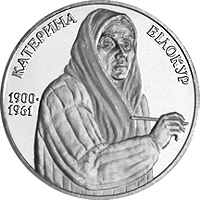Kateryna Bilokur
[4] Numerous sources report a popular legend that Pablo Picasso saw Bilokur's work exhibited in Paris and commented, "If we had an artist of this level, we would make the whole world talk about her.
"[8] She would draw decorations for a local drama club, organized by her neighbor and a distant relative, Nikita Tonkonog.
She embarked on a journey to Myrhorod with two drawings on her: a copy of a painting and a sketch of her grandfather's house, both on paper that she bought especially for this occasion.
Her parents agreed to her participating in plays, but on condition that her acting won't interfere with her house work.
[9] In the spring of 1940, Bilokur heard on the radio a song "Or was I not the viburnum on the meadow" performed by Oksana Petrusenko.
The song impressed Bilokur so much that she wrote a letter to the singer, enclosing a drawing of a viburnum on a piece of canvas.
The drawing struck the singer, and she, after consulting with friends - Vasily Kasiyan and Pavel Tychina - turned to the Folk Art Center.
[10] Vladimir Khitko, who then headed the artistic and methodological council of the regional House of Folk Art, came to visit Bogdanivka.
In 1940, in the House of Folk Art in Poltava, a personal exhibit of the self-taught artist from Bogdanivka opened, which at that time consisted of only 11 paintings.
[16]In 1954, Three paintings by Bilokur - "Tsar Kolos", "Birch", and "Kolkhoz Field" - were included in the exposition of Soviet art at the International Exhibition in Paris ).
[17] It is said the works were seen by Pablo Picasso, who spoke about Bilokur as follows: "If we had an artist of this level, we would have made the whole world talk about her!
[22] Her friends would petition Communist Party leaders that she be allowed to move to Kyiv, but these efforts were denied.
Based on the collections of Bilokur's letters she had pen pals are the poet Pavel Tychina and his wife Lydia Petrovna, the art critic Stefan Taranushenko, director of the Museum of Ukrainian Folk Decorative Arts, Vasily Nagai, artists Elena Kulchitskaya, Matvey Dontsov, Emma Gurovich, and others.
In Bogdanivka, she started teaching students: Olga Binchuk, Tamara Ganzha, and Anna Samarskaya.
Several times she would try depicting a story of a stork bringing a child, but abandoned this idea due to confusion from others.
In the last years of her life, marked by a serious illness, Bilokur created a number of notable canvases: "Daisies" (1958), "Peonies" (1958), "Bohdaniv Apples" (1959), "Bundle of Flowers" (1960) and others.
[28] She did not work often with watercolor and grey pencil because she was more attracted to oil paints: "I made brushes myself - I took hairs of the same length from a cat's tail.


